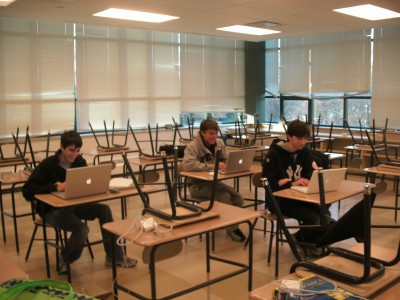Petey Menz ’11
News Editor

On March 6, Todd Lubin ’11 went to bed at 9:00 p.m. Approximately seven and a half hours later, he arrived at Staples High School with his brother Eric Lubin ’11.
The hallway lights were off. Eight other students trickled in along with Math 6–12 Coordinator Frank Corbo and math teacher Gertrude Denton.
These ten students constituted Staples’ two teams for the 2010 Moody’s Mega Math Challenge. From 7:00 a.m. on Sunday morning to 9 p.m. that night, the students worked on solving this year’s problem, which forced them to use their mathematical modeling skills to solve a real world problem.
This year, the problem dealt with the 2010 census. Students had to “provide mathematically-based recommendations for adjusting the population figures for the census” and use relevant data, including information on the 2000 census and its significant undercount, to prove their findings.
Their solution will be evaluated by a board of judges, who will determine whether or not the team can move onto the next round. Ultimately, the top six teams will receive up to $20,000.
At 7:00 a.m., the problem was posted. The reactions of the two teams were audible from the hallway.
“It’s the census problem!” one student shouted.
Soon the talk turned to mathematical modeling. At 7:02 a.m., the hallway lights flickered on.
For the team composed of Joe Stopper ’11, Naveen Murali ’10, Matt Greenberg ’10, Eric Lubin and Todd Lubin, this question came as a surprise.
“We had experimented with some preliminary models for health care, the issue we thought it would be,” Murali said.
Though reactions to this unexpected event were not all positive—Eric Lubin described himself as “disappointed”—they pressed on.
“Even though health care wasn’t the topic, that planning and playing with data really helped us face the topic,” Murali said. “At first we felt a little bummed out, but we had to pick up ourselves and move on and focus on the issue at hand. I think we did a good job with that.”
In addition, the team noted that there were in fact some benefits to the census problem.
“It was better that it was more numbers based than health care would have been,” Eric Lubin said.
The other team had also tried to anticipate the topic.
“We talked [the Challenge] over during math team,” Caroline Wu ’11 said, who was on a team with Tim Yang ’11, Tessa Green ’11, Rachel Myers ’11 and Chenchen Feng ’11.
“We tried to figure out what kind of topics we might be doing and read over past questions.”
However, attempting to guess the topic was not the only way the teams prepared.
All of them had also participated in the Staples Spectacular Challenge, which most thought would give them a fairly good idea of the way Moody’s would work.
“It’ll be good for time management,” Myers said before Moody’s started.
Math teacher Gertrude Denton, who helped run both challenges, believed that participating in the Staples Spectacular Challenge would be an asset to the two teams.
“It’s like a scrimmage before a good game,” Denton said.
As 9:00 p.m. approached, the teams submitted their proposals to Moody’s via the Internet.
According to Eric Lubin, his team submitted their final proposal with about two minutes to go, though they had submitted their first draft fifteen minutes earlier.
According to Green, the other team sent their proposal with about 30 seconds to go.
Denton was optimistic about this year and the future of the Challenge at Staples. Though there are two teams from Staples competing this year, she considered this to be perfectly normal, as Staples has had two teams in the past.
“The best part is that so many of those competing are juniors, so they’ll be able to compete next year,” Denton said.












































